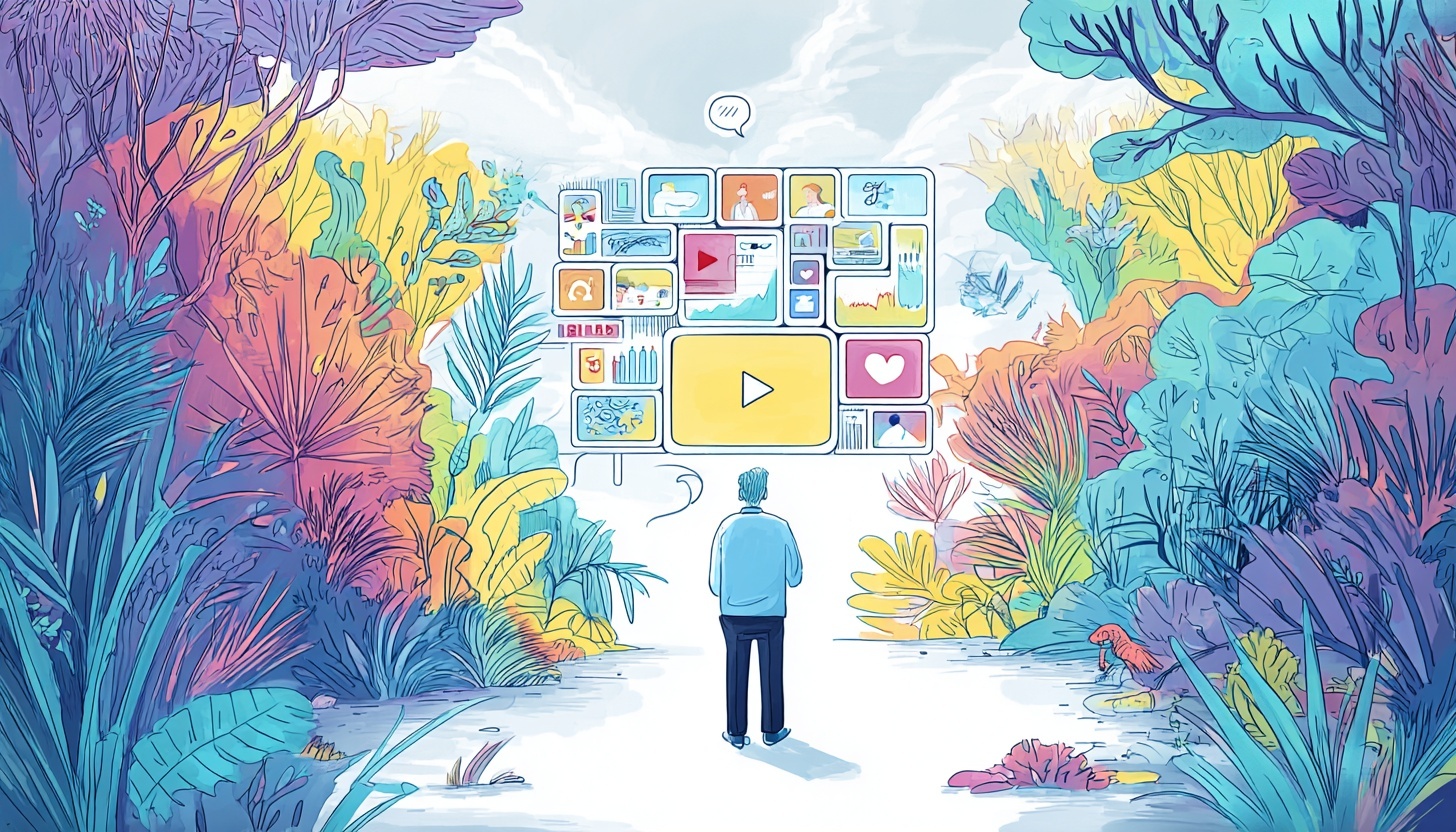Was zeichnet Multiformat-Audioinhalte aus
Bist du ein Marken-Podcast, der immer noch dem gleichen alten Interviewformat folgt? An Interviews ist zwar von Natur aus nichts auszusetzen, aber Podcast-Ersteller, die bereit sind, neue Wege zu beschreiten, bieten sich enorme Chancen.
Der Audioraum wird immer voller. Und angesichts der Tatsache, dass mehr als 5 Millionen Podcasts um Aufmerksamkeit konkurrieren, könnten Podcast-Inhalte in mehreren Formaten die Geheimwaffe sein, die erfolgreiche Sendungen von denen unterscheidet, die im digitalen Lärm verloren gehen.
Podcast-Inhalte mit mehreren Formaten beziehen sich auf Sendungen, die verschiedene Präsentationsstile innerhalb ihrer gesamten Programmstrategie strategisch miteinander verbinden. Anstatt Episode für Folge an einem einzigen Ansatz festzuhalten, könnten diese innovativen Podcasts Einzelkommentare mit Gastinterviews kombinieren, Elemente des fiktiven Geschichtenerzählens einbinden oder interaktive Live-Abschnitte integrieren.
Lesen Sie weiter, um zu erfahren, warum es in einer Zeit, in der sich das Publikum nach Abwechslung und neuen Erlebnissen sehnt, immer wichtiger wird, um die Aufmerksamkeit der Zuhörer zu gewinnen und aufrechtzuerhalten.
Warum Podcast-Inhalte in mehreren Formaten moderne Hörer faszinieren
Inhaltsmüdigkeit durchbrechen
Wir leben in einem Zeitalter der Inhaltssättigung. Hörer haben heute Zugriff auf mehr Audioinhalte, als sie in mehreren Lebenszeiten konsumieren könnten, was eine einzigartige Herausforderung darstellt: Wie halten wir unser Publikum bei der Stange, wenn es unendlich viele Alternativen zur Verfügung hat?
Podcast-Inhalte mit mehreren Formaten lösen dieses Problem, indem sie Unvorhersehbarkeit innerhalb der Vertrautheit schaffen.
Wenn Zuhörer deine Sendung hören, wissen sie, dass sie deine einzigartige Perspektive und Stimme bekommen, aber sie sind sich nie ganz sicher, wie diese Inhalte vermittelt werden. In einer Folge kann es sich um eine intime Einzelreflexion handeln, während die nächste eine dynamische Podiumsdiskussion oder ein immersives erzählerisches Erlebnis sein könnte.
Diese Variante bedient unterschiedliche Hörkontexte hervorragend. Ihr Publikum mag auf dem morgendlichen Arbeitsweg Episoden im Interview-Stil bevorzugen, wenn sie etwas Neues lernen möchten, sich aber dazu hingezogen fühlen Fiktion-Podcasts während der abendlichen Entspannungszeit. Indem wir mehrere Formate anbieten, schaffen wir im Wesentlichen ein Inhaltsbuffet, das die Zuhörer anspricht, wo auch immer sie sich befinden, sowohl physisch als auch mental.
Die Psychologie hinter diesem Ansatz ist faszinierend. Unser Gehirn ist darauf ausgelegt, Neues wahrzunehmen, und wenn wir auf vertraute Inhalte stoßen, die auf unerwartete Weise präsentiert werden, löst das neue Aufmerksamkeit und Engagement aus. Aus diesem Grund zeigt sich, dass erfolgreiche Multiformat-Konzepte oft höhere Abschlussraten und eine stärkere Abonnententreue erzielen als bei vergleichbaren Konzepten, die nur ein Format verwenden.
Erweitern Sie Ihre Reichweite
Hier ist etwas, was viele Podcast-Moderatoren übersehen: Verschiedene Formate ziehen natürlich unterschiedliche demografische Merkmale und Hörerpräferenzen an. Interview-Enthusiasten entdecken Ihre Sendung möglicherweise durch einen Gastauftritt, während Fans von fiktionalen Podcasts auf Ihre erzählerischen Folgen stoßen könnten. Jedes Format dient als einzigartiger Einstiegspunkt in Ihr Inhaltsökosystem.
Untersuchungen von Signal Hill Insights zeigen, dass Erzählshows traditionelle Interviewformate in Bezug auf wichtige Kennzahlen übertreffen. Die Hörer gaben an, dass die Wahrscheinlichkeit, dass sie die Sendung erneut hören, um 14% höher ist, die Wahrscheinlichkeit, dass sie die Sendung weiterempfehlen, um 11% höher ist und die Markenbekanntheit um 10% gestiegen ist. Diese Zahlen stehen für eine echte Zuschauerbindung, was sich in folgenden Punkten niederschlägt nachhaltiges Podcast-Wachstum.
Inhalte in mehreren Formaten erhöhen auch die Auffindbarkeit auf Podcast-Plattformen. Wenn deine Sendung mehrere Kategorien oder Stilpräferenzen umfasst, ist es wahrscheinlicher, dass du in verschiedenen Empfehlungsalgorithmen und Suchergebnissen auftauchst.
Ein Podcast, der sowohl lehrreiche Solo-Episoden als auch unterhaltsame fiktive Segmente enthält, kann potenziell in mehreren Genre-Kategorien platziert werden, wodurch seine potenzielle Reichweite exponentiell erweitert wird.
Unverzichtbare Multiformat-Ansätze, die das Engagement fördern
Erzählgetriebene Fiktion-Podcasts
Fiction-Podcasts sind eines der am wenigsten genutzten und dennoch leistungsstärksten Formate im Multiformat-Toolkit. Obwohl sie nur einen kleinen Prozentsatz der verfügbaren Sendungen enthalten, fiktives Geschichtenerzählen sorgt für ein unglaublich loyales Publikum, weil die Zuhörer von vorne beginnen und den Charakterbögen durch mehrere Folgen folgen müssen.
Die Magie von Fiktion-Podcasts liegt in ihrer Fähigkeit, die Zuhörer in völlig andere Welten zu entführen. Sendungen wie „Deadly Manners“ zeigen, wie fiktive Erzählungen Unterhaltung mit subtilen Markenbotschaften verbinden und so unvergessliche Erlebnisse schaffen können, die das Publikum noch lange nach dem Ende der Episode im Gedächtnis behalten.
Wenn Sie fiktive Elemente in Ihre Multiformat-Strategie integrieren, konzentrieren Sie sich darauf, überzeugende Charaktere und Szenarien zu kreieren, die zu Ihrer gesamten Markenbotschaft passen. Die Geschichte muss nicht aufwändig sein — manchmal kann eine einfache Komödie oder ein Mysterium am Arbeitsplatz effektiver sein als komplexe Science-Fiction. Der Schlüssel liegt in der Konsequenz bei der Charakterentwicklung und der Beibehaltung von Erzählsträngen, die die Zuhörer in das, was als Nächstes passiert, binden.
Was die Produktion angeht, erfordern Fiktion-Podcasts mehr Planung als andere Formate. Du benötigst Drehbücher, möglicherweise Synchronsprecher und viel Aufmerksamkeit beim Sounddesign. Diese Investition zahlt sich jedoch häufig aus Engagement und Einprägsamkeit des Podcast-Publikums.
Episoden, die auf Interviews und Konversationen basieren
Interviews könnten zwar die sein gängigstes Podcast-Format, das heißt nicht, dass sie nicht Teil eines innovativen Multiformat-Ansatzes sein können. Der Trick besteht darin, die generische Formel „Setz dich mit einem Experten“, die den Markt sättigt, zu vermeiden.
Erfolgreiche Multiformat-Sendungen setzen Interviews strategisch ein, vielleicht zeigen sie sie monatlich, während andere Slots mit unterschiedlichen Inhaltstypen besetzt werden. Wenn Sie Interviews führen, sollten Sie Varianten in Betracht ziehen, z. B. Gespräche aus zwei Perspektiven, bei denen Sie Personen mit unterschiedlichen Standpunkten zusammenbringen, oder Episoden im Stil von „Behind the Review“, in denen bestimmte Erfahrungen aus verschiedenen Blickwinkeln beleuchtet werden.
Das Gastauswahlverfahren wird in einer Umgebung mit mehreren Formaten von entscheidender Bedeutung. Anstatt Gäste nur aufgrund von Fachwissen oder Bekanntheit zu buchen, sollten Sie überlegen, wie ihre Geschichte oder Sichtweise in Ihre umfassendere Inhaltsdarstellung passt. Ein gut ausgewählter Gast kann Material für mehrere Folgen in verschiedenen Formaten bereitstellen. Vielleicht führt sein erstes Interview zu einer Solo-Kommentarfolge, in der du über das Gespräch nachdenkst, oder seine Erkenntnisse inspirieren zu einem fiktiven Szenario in einer späteren erzählerischen Episode.
Einzelkommentar und pädagogischer Inhalt
Solo-Episoden bieten Podcast-Moderatoren die vollständige kreative Kontrolle und die Möglichkeit, fundierte Autorität zu bestimmten Themen aufzubauen. In einem Kontext mit mehreren Formaten dienen diese Episoden oft als Grundlage, um experimentelleren Inhalten Kohärenz zu verleihen.
Die Schönheit des Soloformats liegt in seiner Flexibilität und Effizienz. Sie können aufnehmen, wann immer Sie inspiriert sind, tief in Themen eintauchen, die für Ihr Publikum wichtig sind, oder aktuelle Ereignisse zeitnah kommentieren. Sendungen wie „Hardcore History“ beweisen, dass Soloinhalte unglaublich fesselnd sein können, wenn der Moderator ausreichend Fachwissen und Geschichtenerzählfähigkeit ans Mikrofon bringt.
Wenn Sie im Rahmen Ihrer Multiformat-Strategie Solo-Episoden planen, sollten Sie diese als Ankerpunkte betrachten, die Ihre Kernbotschaft und Ihr Fachwissen untermauern. Diese Folgen können Themen aufgreifen, die du in anderen Formaten erörterst, oder sie bieten Kontext und Analysen für Inhalte, die du in Interviews oder Erzählungen behandelt hast.
Der Schlüssel zu erfolgreichen Solo-Inhalten ist Authentizität in Kombination mit Vorbereitung. Sie müssen zwar nicht für jedes Wort ein Drehbuch schreiben, aber wenn Sie eine klare Struktur und die wichtigsten Punkte haben, stellen Sie sicher, dass Ihre Folgen einen Mehrwert bieten und gleichzeitig Ihren natürlichen Sprechstil beibehalten.
Interaktive und Live-Formatintegration
Live-Podcasts und interaktive Elemente stellen den neuesten Stand der Erstellung von Inhalten in mehreren Formaten dar. Diese Ansätze durchbrechen die traditionelle Barriere zwischen dem Ersteller und dem Publikum von Inhalten und fördern Communitys rund um Ihre Sendung, die weit über das passive Zuhören hinausgehen.
Interaktive Formate können Live-Fragerunden, Call-in-Segmente oder sogar Live-Aufzeichnungen regulärer Folgen umfassen, die Sie später für Ihren Hauptfeed bearbeiten. Die Energie und Spontanität von Live-Inhalten sorgen oft für einige der einprägsamsten Podcast-Momente, während sich die Zuhörer durch die interaktiven Elemente eher als aktive Teilnehmer als als passive Verbraucher fühlen.
Technische Überlegungen für Live-Inhalte sind komplexer als aufgezeichnete Folgen, aber der Nutzen, der sich durch das Engagement des Publikums auszahlt, rechtfertigt oft den zusätzlichen Aufwand. Live-Formate bieten auch natürliche Möglichkeiten für Cross-Promotion und Zuschauerwachstum, da die Teilnehmer ihr Engagement häufig mit ihren eigenen Netzwerken teilen.
Strategische Implementierung von Podcast-Inhalten in mehreren Formaten
Planung Ihres Inhaltskalenders
Die erfolgreiche Verwaltung von Podcast-Inhalten in mehreren Formaten erfordert eine durchdachte Planung und strategische Überlegungen darüber, wie verschiedene Formate zusammenarbeiten, um Ihre Gesamtziele zu erreichen. Wir empfehlen, mit einem vierteljährlichen Planungsansatz zu beginnen, bei dem die Verteilung der Formate auf der Grundlage Ihrer Zielgruppenpräferenzen, saisonaler Überlegungen und verfügbarer Ressourcen festgelegt wird.
Analysieren Sie zunächst Ihre vorhandenen Zielgruppendaten, um zu verstehen, welche Themen und Präsentationsstile das stärkste Engagement hervorrufen. Verwenden Sie diese Informationen, um eine grundlegende Formatverteilung festzulegen — vielleicht könnten Sie 40% Einzelfolgen, 30% Interviews, 20% erzählerischen Inhalt und 10% experimentelle Formate ausprobieren. Bei diesen Prozentsätzen handelt es sich nicht um starre Regeln, sondern um Ausgangspunkte, die Sie je nach Leistung und Feedback der Zuschauer anpassen können.
Überlegen Sie, wie unterschiedlich Podcast-Formate können sich gegenseitig ergänzen in Ihrem Inhaltskalender. Ein Monat kann mit einer Einzelfolge beginnen, in der ein Thema vorgestellt wird, dann mit Interviews, in denen verschiedene Perspektiven zu diesem Thema untersucht werden, und mit einer erzählerischen Episode enden, die das Thema anhand von Geschichten veranschaulicht. Bei diesem Ansatz entstehen Inhaltsreihen, die sich gewollt und zusammenhängend anfühlen, während gleichzeitig die Formatvielfalt gewahrt bleibt.
Aufrechterhaltung der Markenkonsistenz in allen Formaten
Eine der größten Herausforderungen bei der Erstellung von Inhalten in mehreren Formaten besteht darin, eine konsistente Markenstimme und -botschaft über verschiedene Präsentationsstile hinweg aufrechtzuerhalten. Ihr Publikum sollte Ihre Sendung immer wiedererkennen, unabhängig davon, ob es sich einen Einzelkommentar oder eine fiktive Erzählung anhört.
Legen Sie klare Markenrichtlinien fest, die Formatgrenzen überschreiten. Dazu gehören konsistente Intro- und Outro-Sequenzen, wiederkehrende Themen oder Phrasen, die in allen Folgen vorkommen, und ein Gesamtton, der Ihre Markenpersönlichkeit widerspiegelt. Ihre Stimme und Perspektive sollten der rote Faden sein, der alle Formate verbindet, auch wenn die Bereitstellung der Inhalte stark variiert.
Erwägen Sie, formatspezifische Vorlagen zu erstellen, die die Markenkonsistenz wahren und gleichzeitig kreative Variationen ermöglichen. Ihre Interview-Folgen können immer eine bestimmte Art von Eingangsfrage enthalten, während Ihre Solo-Folgen einer einheitlichen Struktur folgen könnten, die die Zuhörer erwarten und schätzen.
Ressourcenzuweisung und Produktionsabläufe
Verschiedene Formate erfordern unterschiedliche Zeit- und Ressourceninvestitionen, und erfolgreiche Multiformat-Shows planen entsprechend. Fiktion-Podcasts erfordern in der Regel mehr Arbeit vor der Produktion, einschließlich Drehbuch und Sounddesign, während Solo-Folgen möglicherweise weniger Planung, aber mehr Nachbearbeitung erfordern, um die Qualität aufrechtzuerhalten.
Entwickeln Sie Produktionsabläufe, die diese Variationen berücksichtigen, ohne Ihr Team oder Ihr Budget zu überfordern. Dies kann bedeuten, dass Sie Aufnahmen in ähnlichen Formaten stapeln, Partnerschaften mit Synchronsprechern oder Gastexperten eingehen oder Inhaltsvorlagen erstellen, die den Erstellungsprozess optimieren.
Moderne Podcast-Produktionstools können Workflows mit mehreren Formaten erheblich rationalisieren. KI-gestützte Transkription und Plattformen zur Inhaltsgenerierung wie Castmagic Ersteller können einzelne Aufzeichnungen automatisch in mehrere Inhaltselemente umwandeln und so aus einem einzelnen Interview Shownotizen machen, Beiträge in sozialen Netzwerken, Blogartikel und Newsletter-Inhalte. Dieser Ansatz maximiert den Wert jedes einzelnen Inhalts und unterstützt gleichzeitig die Formatvielfalt, ohne die Produktionszeit proportional zu verlängern.
Denken Sie daran, dass nicht jede Episode ein Meisterwerk der Produktion sein muss. Manchmal kann ein spontaner Solo-Kommentar, der auf Ihrem Telefon aufgenommen wurde, ansprechender sein als ein überproduziertes Interview. Der Schlüssel liegt darin, konsistente Qualitätsstandards aufrechtzuerhalten und gleichzeitig kreative Flexibilität innerhalb Ihrer Ressourcenbeschränkungen zu ermöglichen.
Maximierung der Hörerbindung durch Formatvielfalt
Erstellen nahtloser Formatübergänge
Die erfolgreiche Einführung neuer Formate für Ihr bestehendes Publikum erfordert eine sorgfältige Kommunikation und schrittweise Umsetzung. Ihre treuen Zuhörer haben sich aus bestimmten Gründen für Ihre Sendung entschieden, und dramatische Formatänderungen können sich erschütternd anfühlen, wenn sie nicht sorgfältig behandelt werden.
Führen Sie zunächst schrittweise und mit klaren Erklärungen Formatvariationen ein. Wenn Sie einer Sendung, die zuvor nicht fiktiv war, fiktive Elemente hinzufügen, erläutern Sie Ihre Überlegungen und machen Sie den Zuhörern klar, wie dieser neue Inhalt Ihrer allgemeinen Mission dient. Erwägen Sie, spezielle Ankündigungsfolgen zu erstellen, die eine Vorschau auf bevorstehende Formatänderungen bieten, und holen Sie Feedback des Publikums ein.
Verwenden Sie konsistente Branding-Elemente, um den Zuhörern zu zeigen, dass verschiedene Formate immer noch zur selben Show-Familie gehören. Behalten Sie Ihre charakteristische Intro-Musik bei, sorgen Sie für eine einheitliche Episodennummerierung und stellen Sie sicher, dass die Stimme Ihres Gastgebers in allen Formaten authentisch bleibt.
Entwicklung formatspezifischer Engagement-Strategien
Jeder Formattyp bietet einzigartige Möglichkeiten, das Publikum zu engagieren, und erfolgreiche Multiformat-Shows entwickeln spezifische Strategien, um diese Möglichkeiten zu maximieren. Interview-Episoden könnten die Zuhörer dazu ermutigen, zukünftige Gäste vorzuschlagen oder Fragen zu stellen, während erzählerische Episoden durch Cliffhanger und Charakterentwicklung die Vorfreude wecken könnten.
Werbung in sozialen Medien sollte der Vielfalt der Formate Rechnung tragen, wobei unterschiedliche Arten von Inhalten unterschiedliche Werbeansätze erfordern. Inhalte hinter den Kulissen eignen sich gut für fiktionale Podcasts, während Zitatgrafiken für Interview-Episoden effektiver sein könnten. Entwickeln Sie eine Werbestrategie, die den einzigartigen Wert jedes Formats hervorhebt und gleichzeitig die allgemeine Markenkonsistenz gewährleistet.
Überlegen Sie, wie verschiedene Formate das Cross-Engagement innerhalb Ihres Content-Ökosystems fördern können. Hörer, die deine Sendung durch fiktionale Podcasts entdecken, interessieren sich möglicherweise für deine lehrreichen Solo-Episoden, während Interviewfans vielleicht die tieferen Einblicke in erzählerische Formate zu schätzen wissen. Intelligente Inhaltsersteller verwenden Transkriptionstools, um überzeugende Zitate und Highlights aus jedem Formattyp zu extrahieren und Inhalte zu erstellen, die gemeinsam genutzt werden können, um neue Hörer anzuziehen und gleichzeitig bestehende Fans zu bedienen.
Wir begrüßen die Zukunft der Erstellung von Audioinhalten
Podcast-Inhalte in mehreren Formaten sind die Weiterentwicklung des Audio-Storytellings als Reaktion auf sich ändernde Hörererwartungen und Konsummuster von Inhalten. Indem wir uns die Vielfalt der Formate zunutze machen, schaffen wir Sendungen, die widerstandsfähiger und fesselnder sind und in der Lage sind, in einem zunehmend wettbewerbsintensiven Unterhaltungsbereich ein nachhaltiges Publikum zu gewinnen.
Die Podcaster, die in den kommenden Jahren erfolgreich sein werden, werden diejenigen sein, die Formatbeschränkungen eher als kreative Herausforderungen denn als Einschränkungen betrachten. Sie werden verstehen, dass sich ihr Publikum sowohl nach Beständigkeit als auch nach Überraschungen sehnt. Bekannte Stimmen erkunden neue Wege, Geschichten und Erkenntnisse zu teilen. Diese YouTuber werden auch Technologie nutzen, um ihre Produktionsprozesse für mehrere Formate zu optimieren, indem sie KI-gestützte Tools verwenden, um Inhalte auf verschiedenen Formaten und Plattformen effizient wiederzuverwenden.
Fangen Sie klein an mit Ihren Multiformat-Experimenten. Wählen Sie ein zusätzliches Format, das zu Ihrer Marke und Ihren Zielgruppeninteressen passt, und erweitern Sie dann schrittweise Ihr Repertoire, während Sie Selbstvertrauen aufbauen und Feedback vom Publikum einholen. Denken Sie daran, dass das Ziel nicht darin besteht, jedes mögliche Format zu beherrschen, sondern die Kombination zu finden, die Ihrer individuellen Stimme und den Bedürfnissen Ihres Publikums am besten entspricht.
Die Welt der Audioinhalte entwickelt sich rasant, und Multiformat-Ansätze ermöglichen es Ihrem Podcast, sich anzupassen und erfolgreich zu sein, unabhängig davon, wie sich die Hörgewohnheiten ständig ändern. Moderne Tools zur Erstellung von Inhalten machen es einfacher denn je, mit verschiedenen Formaten zu experimentieren und gleichzeitig effiziente Produktionsabläufe aufrechtzuerhalten. Ihr Publikum wartet darauf, herauszufinden, was Ihre mehrformatigen Podcast-Inhalte auszeichnet. Es ist an der Zeit, ihnen etwas zu zeigen, was sie noch nie zuvor gehört haben.
Start Repurposing Media with Castmagic
Paste a link from:









Place a link to 1 media file below and get 100+ content assets instantly.
Castmagic transforms your audio and video into blogs, social posts, newsletters, show notes, and more.
Start Repurposing Your Media

Click or drag your audio/video file here
One upload. Generate endless content.
1. Upload Media File: Drag and drop your audio or video file.
2. Get Instant Transcript: 99% accurate, perfectly formatted, speaker-labeled transcripts in 60+ languages.
3. Generate Content: Create publish-ready blogs, social posts, newsletters, and more with AI.

Automate Your Content Workflow with AI










